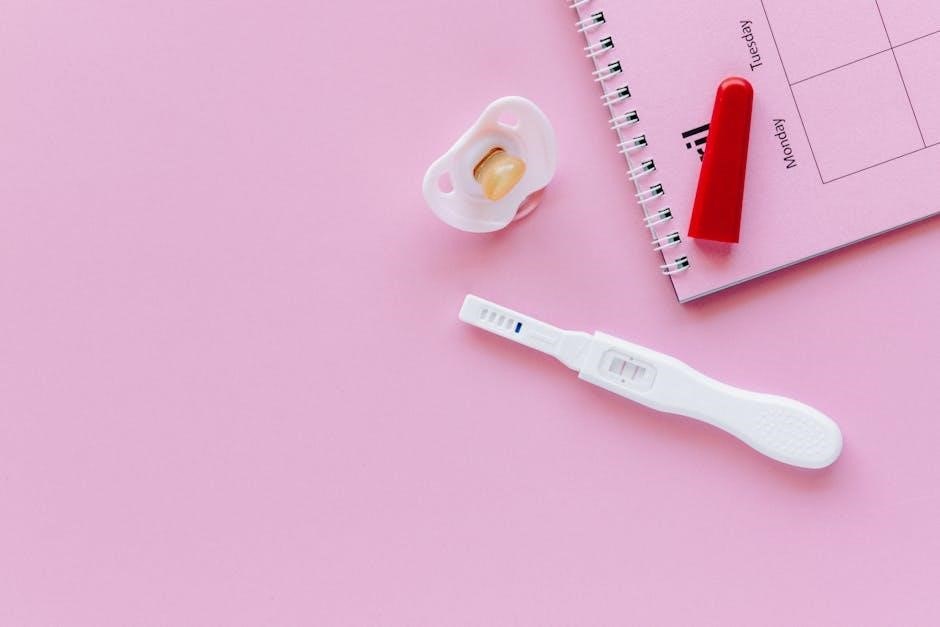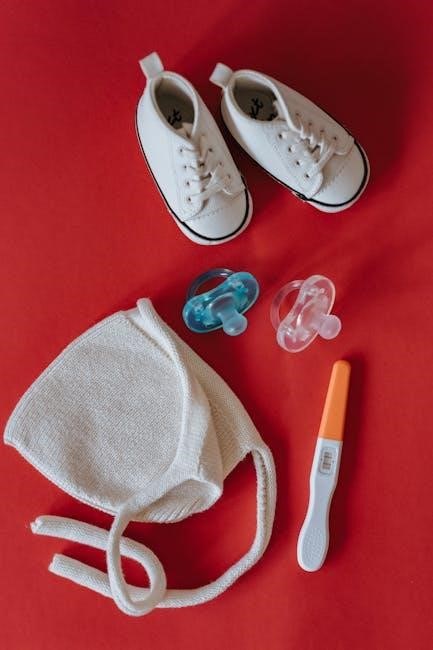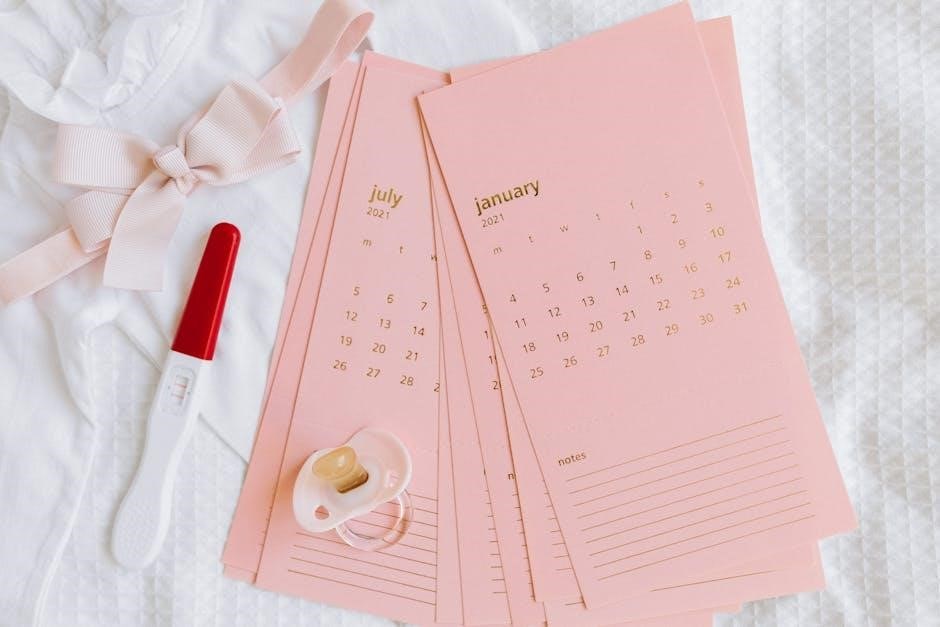Birthing positions refer to the various physical postures a pregnant woman can adopt during labor and delivery. Exploring different positions can potentially influence comfort, labor progress, and overall birth experience.
Overview of Birthing Positions and Their Importance
Birthing positions encompass a range of postures, including standing, squatting, kneeling, and side-lying, each potentially offering unique advantages during labor. The selection of a birthing position is a crucial aspect of the birthing process, influencing comfort, labor duration, and the physiological mechanics of childbirth. Upright positions, in particular, harness gravity to aid the baby’s descent, while other positions can optimize pelvic opening and reduce back pressure. Understanding and exploring these various options allows expectant mothers to actively participate in their birthing experience, promoting a sense of control and empowerment.

Benefits of Upright Birthing Positions
Upright birthing positions, like squatting and standing, utilize gravity to assist the baby’s descent. They facilitate pelvic movement, potentially reducing labor time and pain, and promoting a more efficient birthing process.
Gravity Assistance and Pelvic Movement
Upright birthing positions leverage gravity to aid the baby’s descent through the birth canal. These positions also encourage optimal pelvic movement, allowing the bony joints of the pelvis to shift and adjust to accommodate the baby’s passage. This increased mobility can create more space within the pelvis, potentially facilitating a smoother and more efficient labor process. The natural alignment promoted by upright positions may also reduce strain and discomfort during contractions.
Potential for Reduced Labor Time and Pain
Adopting upright birthing positions may contribute to a shorter labor duration and a decrease in perceived pain. Gravity’s assistance, combined with enhanced pelvic mobility, can optimize the baby’s descent, potentially leading to faster progress. Furthermore, these positions may alleviate pressure on the back and spine, reducing discomfort during contractions. By promoting a more natural and efficient birthing process, upright positions can positively impact both the length and intensity of labor.

Common Upright Birthing Positions
Several upright positions are frequently utilized during labor and delivery. These include standing, walking, squatting, and kneeling, each offering unique advantages for comfort and labor progression.
Standing and Walking
Standing and walking during labor can be beneficial as gravity aids in the baby’s descent. This position may also help to progress labor and reduce back pressure. Gentle swaying motions while standing can further ease discomfort. Furthermore, mobility promotes circulation and can provide a sense of control. Walking encourages pelvic movement, potentially optimizing the baby’s position for birth and contributing to a more positive birthing experience for the laboring person.
Squatting and Kneeling
Squatting helps widen the pelvic outlet, creating more space for the baby to descend, which can make pushing more efficient. Kneeling, on the other hand, offers a compromise if full squatting is challenging. It can also relieve back pressure. Both positions encourage pelvic mobility and can be modified for comfort using support aids. Experimenting with these positions may help to find a comfortable and effective birthing posture for the laboring person, potentially leading to a more satisfying birth experience.

Other Birthing Positions
Besides upright positions, other options exist, including hands and knees and side-lying. Each has unique benefits and may be preferred based on comfort or medical considerations during labor and delivery.
Hands and Knees Position
The hands and knees position, also known as the quadruped position, involves being on all fours during labor. This position can help relieve back pain by taking pressure off the spine. It may also assist in rotating the baby if they are in a posterior position, potentially facilitating a smoother delivery. Furthermore, it offers flexibility and can be easily modified with pillows for added comfort and support during contractions.
Side-Lying Position
The side-lying position involves lying on your side during labor, often with pillows supporting your head, belly, and legs. This position can be particularly beneficial for resting and conserving energy during a long labor. It also promotes optimal blood flow to the baby and can help lower blood pressure. Additionally, it is a good option for women with epidurals as it minimizes pressure on the lower back and facilitates pelvic relaxation, potentially aiding in fetal descent.

Tools for Birthing Positions
Various tools can assist in adopting different birthing positions. These tools are designed to enhance comfort and support mobility during labor. These include birthing balls and stools to help you.
Birthing Balls and Peanut Balls

Birthing balls, large inflatable balls, offer support and promote pelvic movement. They can be used for sitting, leaning, or rocking, potentially easing discomfort and encouraging fetal descent. Peanut balls, shaped like peanuts, are placed between the legs while lying down, which can help open the pelvis and promote labor progress, especially when an epidural is in place. These tools facilitate comfortable and dynamic birthing positions.
Birthing Stools and Squatting Bars
Birthing stools are designed to support a squatting position, which can widen the pelvic outlet and facilitate the baby’s descent. Squatting bars, often found in birthing centers, provide support while squatting or semi-squatting. These tools allow women to harness gravity’s assistance and maintain an upright posture. They can enhance pushing efforts and potentially reduce the duration of the second stage of labor by optimizing pelvic space. These tools require assistance from a partner or medical staff.

Considerations for Choosing a Birthing Position
Selecting a birthing position involves considering personal comfort, medical conditions, and the use of pain medication. Open communication with healthcare providers ensures informed decisions aligned with individual needs and circumstances during labor.
Comfort and Personal Preference
A crucial aspect of choosing a birthing position is prioritizing comfort and personal preference. Every woman experiences labor differently, so what feels natural and supportive for one may not for another. Experimenting with various positions during pregnancy and early labor can help identify those that promote relaxation and ease discomfort. Ultimately, selecting a position that aligns with individual instincts and comfort levels can contribute to a more positive and empowering birth experience. Remember, there is no single “best” position, only the one that feels right for you.
Medical Conditions and Epidural Use
Certain medical conditions might influence the suitability of specific birthing positions. Discuss any pre-existing health concerns with your healthcare provider to determine safe and appropriate options. Furthermore, the use of an epidural can impact mobility and sensation, potentially limiting the range of feasible positions. While an epidural can provide pain relief, it may require adjustments to the birthing environment and necessitate assistance in changing positions. Open communication with your medical team is essential to ensure a safe and comfortable birthing experience, tailored to your individual circumstances and pain management choices.

Positions to Avoid
Avoid lying flat on your back during labor. This position can compress major blood vessels, potentially reducing blood flow to the uterus and baby. Other positions might be more beneficial.
Lying on the Back
Lying flat on the back during labor is generally discouraged. This position can compress the vena cava, a major blood vessel, potentially leading to decreased blood flow to both the mother and the baby. This reduced blood flow can cause dizziness, nausea, and fetal distress. Furthermore, it may hinder the baby’s descent through the birth canal due to the angle of the pelvis. Explore alternative positions that promote better circulation and facilitate the birthing process for a more comfortable and safer experience.

Pushing Positions
Selecting the optimal pushing position is crucial for effective delivery. Various positions, including squatting, side-lying, and hands-and-knees, can be explored to maximize comfort and facilitate the baby’s descent through the birth canal;
Effective Pushing Techniques in Different Positions
Effective pushing involves coordinated efforts between the mother and her body, regardless of the chosen position. Techniques vary, but generally involve deep breaths, focused energy, and listening to the body’s natural urges. Whether squatting, side-lying, or on all fours, proper technique can optimize pushing efforts. Communication with the birth team is essential. Understanding how each position affects pelvic floor engagement is key for successful, efficient pushing and minimizing potential strain or tearing during the final stages of labor and delivery.

Resources for Learning More
Numerous resources are available to deepen your understanding of birthing positions. These include PDF guides, visual aids, and informative websites offering comprehensive details on techniques and benefits of different birthing positions.
PDF Guides and Visual Aids
For those seeking detailed information, PDF guides offer comprehensive overviews of various birthing positions, including step-by-step instructions and illustrations. Visual aids, such as diagrams and videos, can further enhance understanding by demonstrating proper techniques and highlighting the benefits of each position. These resources can empower expectant mothers and their partners to make informed decisions about their birthing experience. Consulting these guides allows for a deeper exploration into optimal positions.
